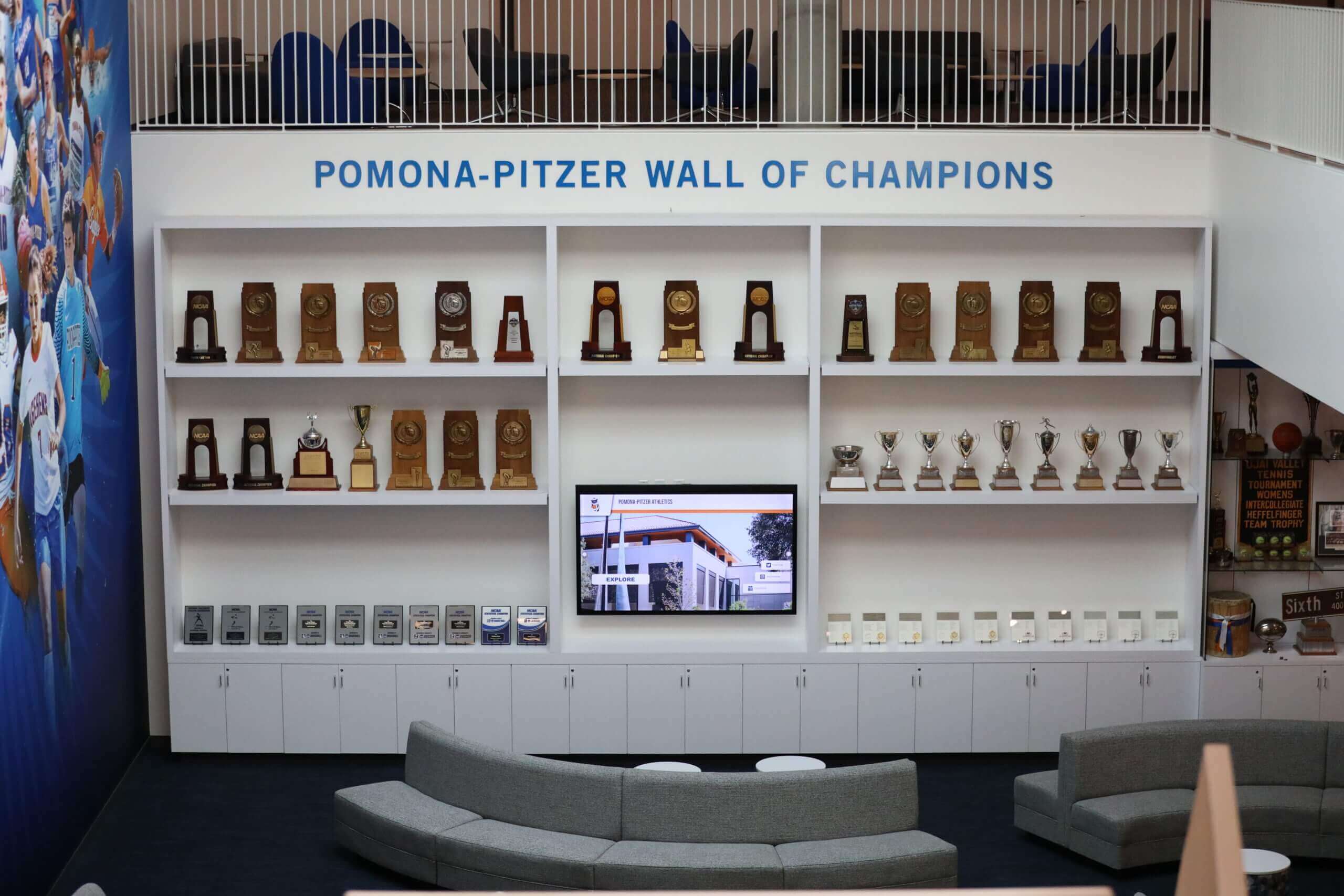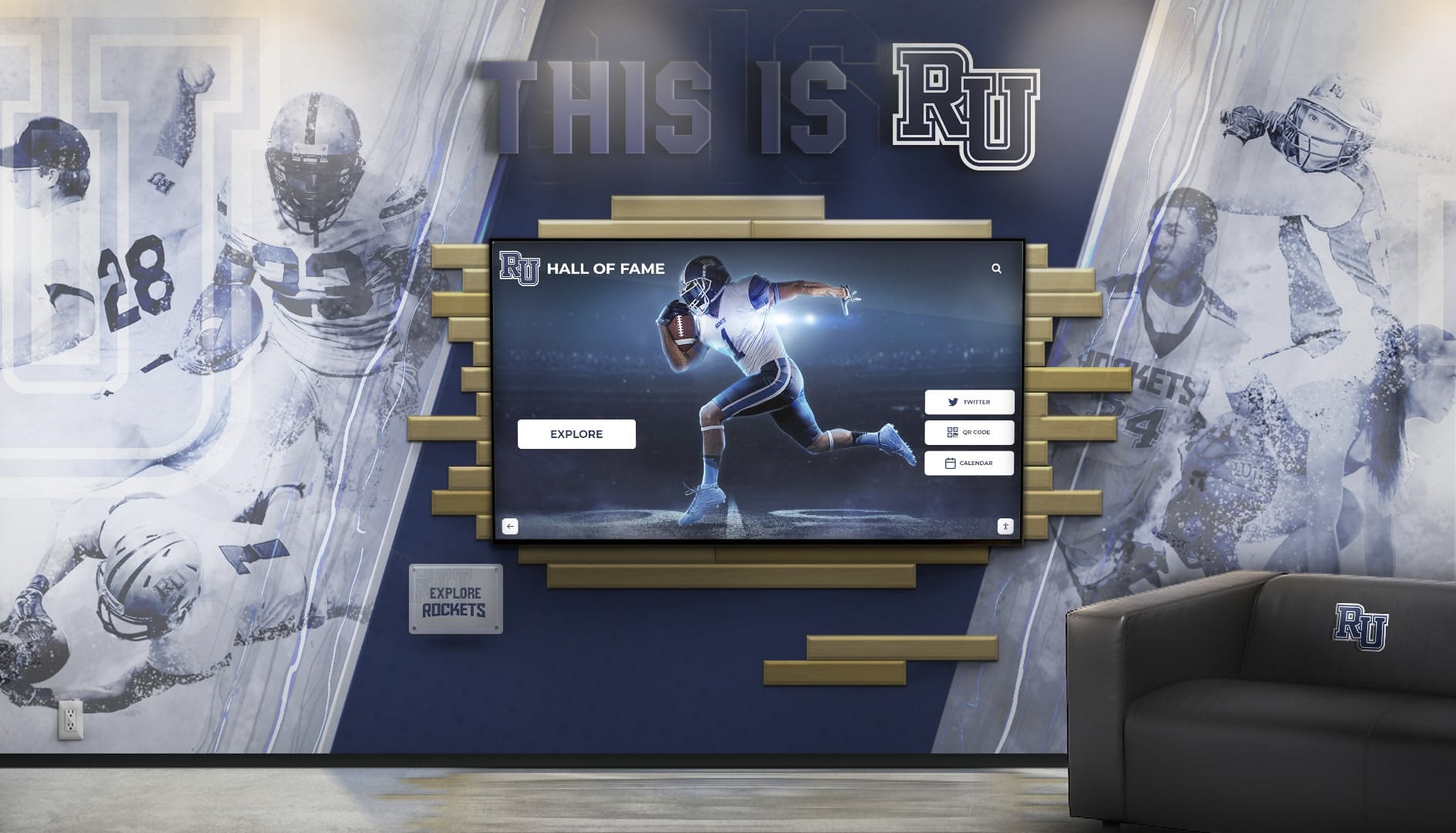Key Takeaways
Comprehensive guide to celebrating fall sports state championships. Learn how schools honor football, soccer, volleyball, and cross country champions through digital displays, recognition ceremonies, and lasting tributes.
Understanding Fall Sports State Championships
Fall sports seasons across the United States feature intense competition culminating in state championship tournaments that determine the best teams and athletes in each state. These championships represent the highest achievement level available to high school athletes during the autumn months.
Primary Fall Sports and Championship Formats
The major fall sports that crown state champions typically include football, volleyball, soccer (both boys and girls in many states), cross country, and in some regions, field hockey, water polo, and competitive cheer. Each sport features unique championship formats designed to identify the top teams through fair competition.
Football State Championships typically feature playoff brackets organized by school classification or enrollment size, with teams advancing through regional and state playoff rounds over several weeks. Many states hold championship games at major college or professional stadiums, creating memorable venues that honor the significance of state title games. Championship weekend often features multiple classification finals played across several days, allowing schools of all sizes to compete for state titles in appropriate competitive divisions.
Volleyball State Championships commonly utilize tournament formats with pool play leading to single-elimination brackets, or direct single-elimination tournaments for qualified teams. State volleyball championships frequently take place at large arena or coliseum venues with multiple courts, allowing several matches to occur simultaneously during tournament days. The tournament atmosphere creates electric environments where championship teams celebrate dramatic victories before enthusiastic crowds.
Soccer State Championships follow playoff bracket structures similar to football, with regional tournaments feeding into state semifinals and finals. Many states conduct both boys and girls soccer state championships during the fall season, doubling the championship opportunities. Soccer finals often take place at prominent soccer complexes or college stadiums, providing quality playing surfaces and spectator accommodations that reflect championship significance.
Cross Country State Championships bring together the top individual runners and teams for decisive state meet competitions at designated courses. Unlike team sports with playoff brackets, cross country determines state champions through single-day state meet races where the lowest team scores win championships. The individual nature combined with team scoring creates unique championship experiences where individual excellence contributes to team success.
Understanding the specific formats and traditions of each fall sport helps schools plan appropriate recognition that honors the unique characteristics and achievements within each championship context.
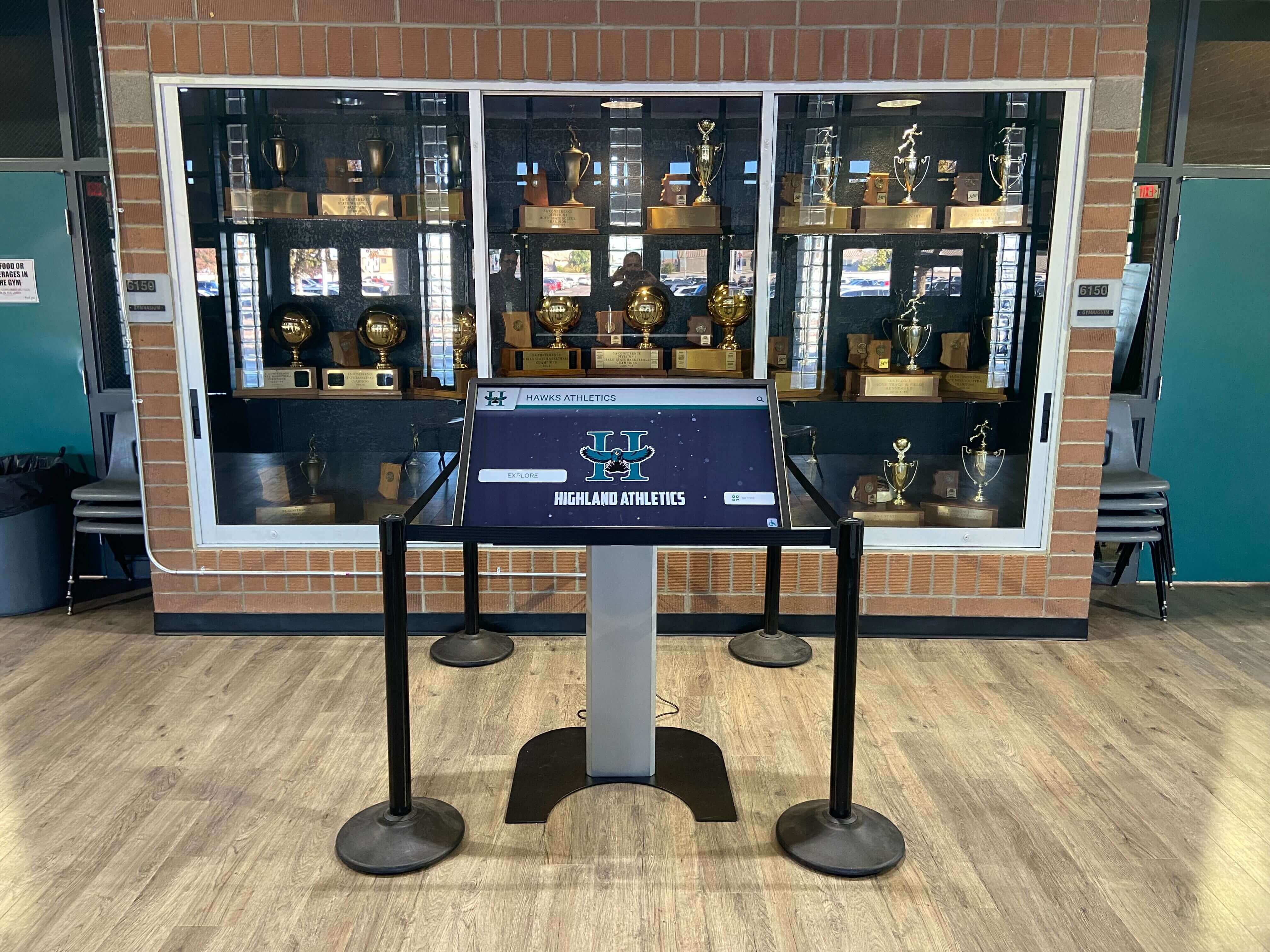
Historical Significance and Tradition
State championships carry profound meaning that extends beyond single seasons. For many schools, state titles represent rare pinnacle achievements reached only occasionally across decades of competition. Even for successful programs that regularly compete for championships, each title holds unique significance with its own story of challenges overcome and excellence demonstrated.
The historical weight of championship achievement makes proper recognition essential. Schools that fail to adequately commemorate state championships miss opportunities to preserve important institutional history while denying future students the inspiration that comes from understanding past excellence. Championship recognition serves dual purposes—honoring those who achieved greatness while establishing standards and aspirations for future athletes.
Traditional championship recognition often included trophy cases, championship banners hung in gymnasiums, team photos displayed in hallways, and plaques listing championship years. While these approaches provided visible acknowledgment, they frequently suffered from space limitations that forced difficult decisions about what to display and what to store away. Modern digital recognition displays overcome these limitations while creating more engaging and comprehensive championship tributes.
Immediate Championship Recognition and Celebration
The period immediately following state championship victories provides crucial opportunities for celebration and recognition that honor achievement while it remains fresh and exciting for school communities.
Championship Victory Celebrations
The moments immediately after championship victories create powerful memories for student-athletes, coaches, and fans. Many schools organize immediate celebrations that acknowledge achievement while emotions run high:
Schools often arrange on-site trophy presentations immediately following championship games or meets, with school administrators, athletic directors, or booster club leaders presenting championship trophies before assembled crowds. These presentations validate achievement in the moment while providing photo opportunities that document historic victories.
Championship parade routes from competition venues back to schools allow communities to celebrate together, with fire truck escorts, horn honking, and crowds lining streets to cheer returning champions. These spontaneous community celebrations demonstrate how championship achievements unite entire communities in shared pride and excitement.
School arrival celebrations greet returning championship teams with assembled student bodies, marching bands, cheerleaders, and welcome signs that transform school parking lots or gymnasiums into celebration venues. The energy and enthusiasm of these receptions communicate to championship teams that their achievements matter deeply to school communities.
Many schools document these immediate celebrations through photos and videos that become valuable historical records and content for digital recognition displays. Capturing authentic celebration moments provides compelling visual content that brings championship stories to life for future viewers.
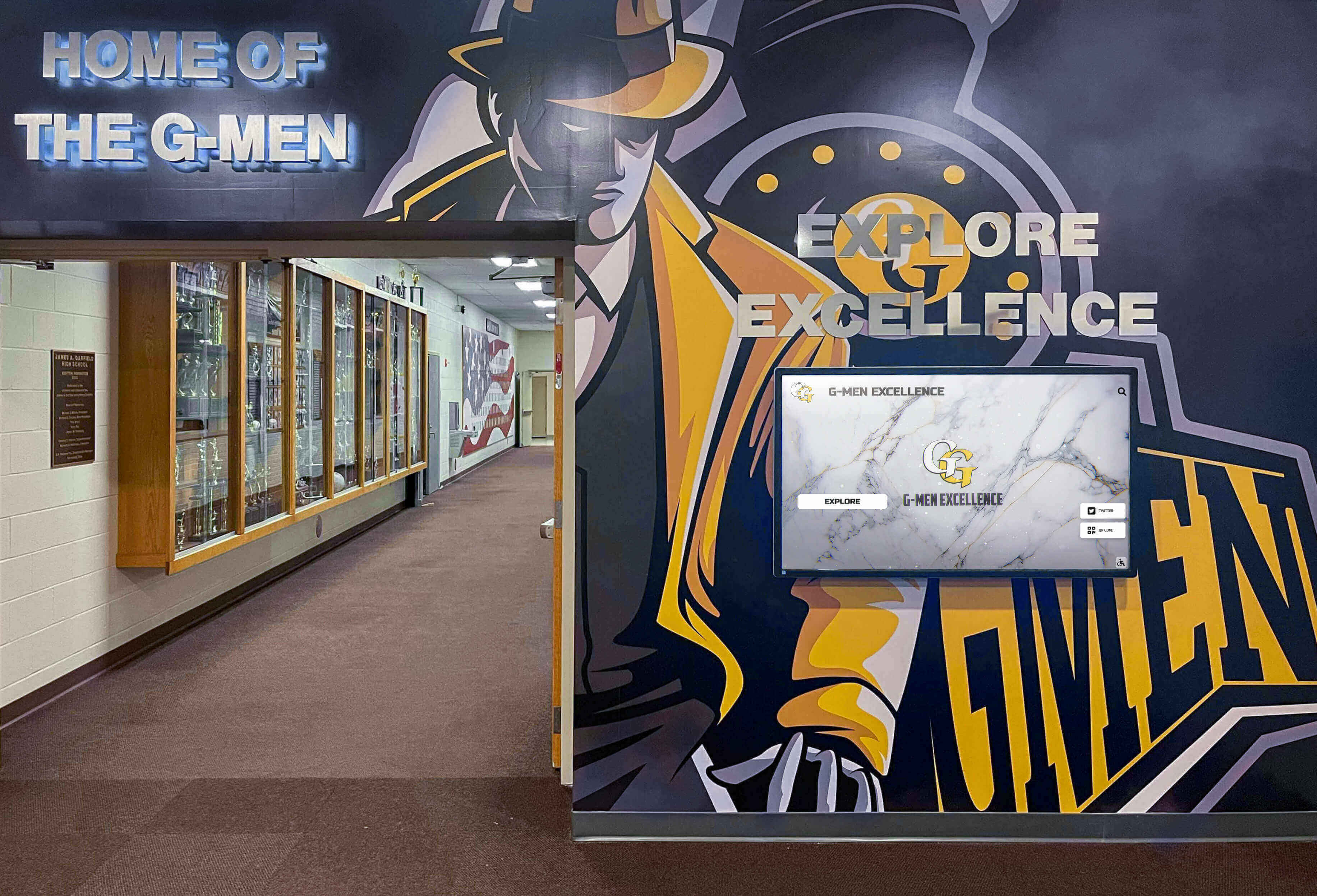
Social Media and Digital Celebration
In today’s digital age, championship celebrations extend across social media platforms where schools share victories with extended communities including alumni, families unable to attend games, and broader athletic communities.
Effective social media championship recognition includes immediate victory announcements posted from championship venues with photos of celebrating teams, championship trophies, and score updates. Player and coach recognition posts highlight individual contributors and coaching staff with action photos, statistics, and quotes that personalize championship stories. Behind-the-scenes content shares locker room celebrations, trophy presentations, and travel home experiences that provide intimate glimpses into championship moments.
Video highlight compilations of championship game or meet performances allow broader audiences to experience key moments that determined championships. These videos become valuable permanent records while generating engagement and sharing across social networks. Schools might create separate highlight videos for different audiences—short clips optimized for Instagram and TikTok, longer highlight reels for YouTube and school websites.
Social media championship coverage extends recognition beyond those physically present while creating digital archives that preserve championship memories. This content also feeds into digital recognition displays where schools can feature social media posts, videos, and community reactions as part of comprehensive championship tributes.
Planning Championship Recognition Ceremonies
Following initial celebrations, schools should organize formal recognition ceremonies that provide structured opportunities to honor championship achievements with appropriate dignity and significance.
Championship Assembly Programs
School-wide assemblies dedicated to championship recognition bring entire student bodies together to celebrate athletic excellence while educating all students about championship significance:
Effective championship assemblies include championship team introductions where each team member receives individual recognition before assembled peers. Calling each athlete’s name and having them stand or come forward ensures every team member receives personal acknowledgment for their contributions. Coach presentations allow head coaches and assistant coaches to address student bodies, sharing championship journey stories, acknowledging key moments, and recognizing support from school communities.
Video presentations showing championship game or meet highlights bring athletic achievements to life for students who may not have attended championships in person. Seeing actual competition footage helps non-athlete students understand the excellence required to win state championships while building school-wide appreciation for athletic achievement. Championship trophy displays at assemblies allow all students to see actual state championship hardware, making abstract concepts of championship success tangible and concrete.
Student recognition opportunities where student government leaders, cheerleaders, or pep band members acknowledge championship teams demonstrate that athletic excellence represents school-wide achievement rather than just athletic department success. This inclusive approach builds broader school pride while validating championship accomplishments across diverse student populations.
Championship assemblies create memorable recognition moments for honored athletes while fulfilling important educational and cultural functions within schools by demonstrating that exceptional achievement receives appropriate celebration and recognition.
Athletic Banquet Recognition
Season-ending athletic banquets provide appropriate settings for comprehensive championship recognition that includes teams, individual athletes, coaches, and supporting personnel:
Championship banquets typically feature formal championship team presentations with extended time dedicated to championship team recognition beyond other seasonal awards. This emphasis signals championship achievement’s special significance while allowing thorough acknowledgment of championship journeys. Coach speeches and reflections give coaching staffs opportunities to share detailed championship season narratives, acknowledging specific games, turning points, challenges overcome, and growth demonstrated throughout seasons.
Individual player recognition within championship team presentations highlights specific contributions different athletes made toward championship success. While championships represent team achievements, acknowledging individual excellence within team contexts provides appropriate recognition for standout performers while maintaining team achievement emphasis. Parent and family acknowledgments recognize the crucial support roles families play in enabling student-athletes to reach championship levels, validating the sacrifices and commitments families make alongside athletes.
Championship memento presentations at banquets might include championship rings, medals, watches, or other commemorative items that provide lasting physical reminders of championship achievements. Many championship teams treasure these items throughout their lives as tangible connections to championship memories. Resources about athletic recognition programs offer frameworks for comprehensive championship celebration approaches.
Athletic banquets also provide appropriate settings for unveiling plans for permanent championship recognition displays, building anticipation while demonstrating institutional commitment to preserving championship legacies.
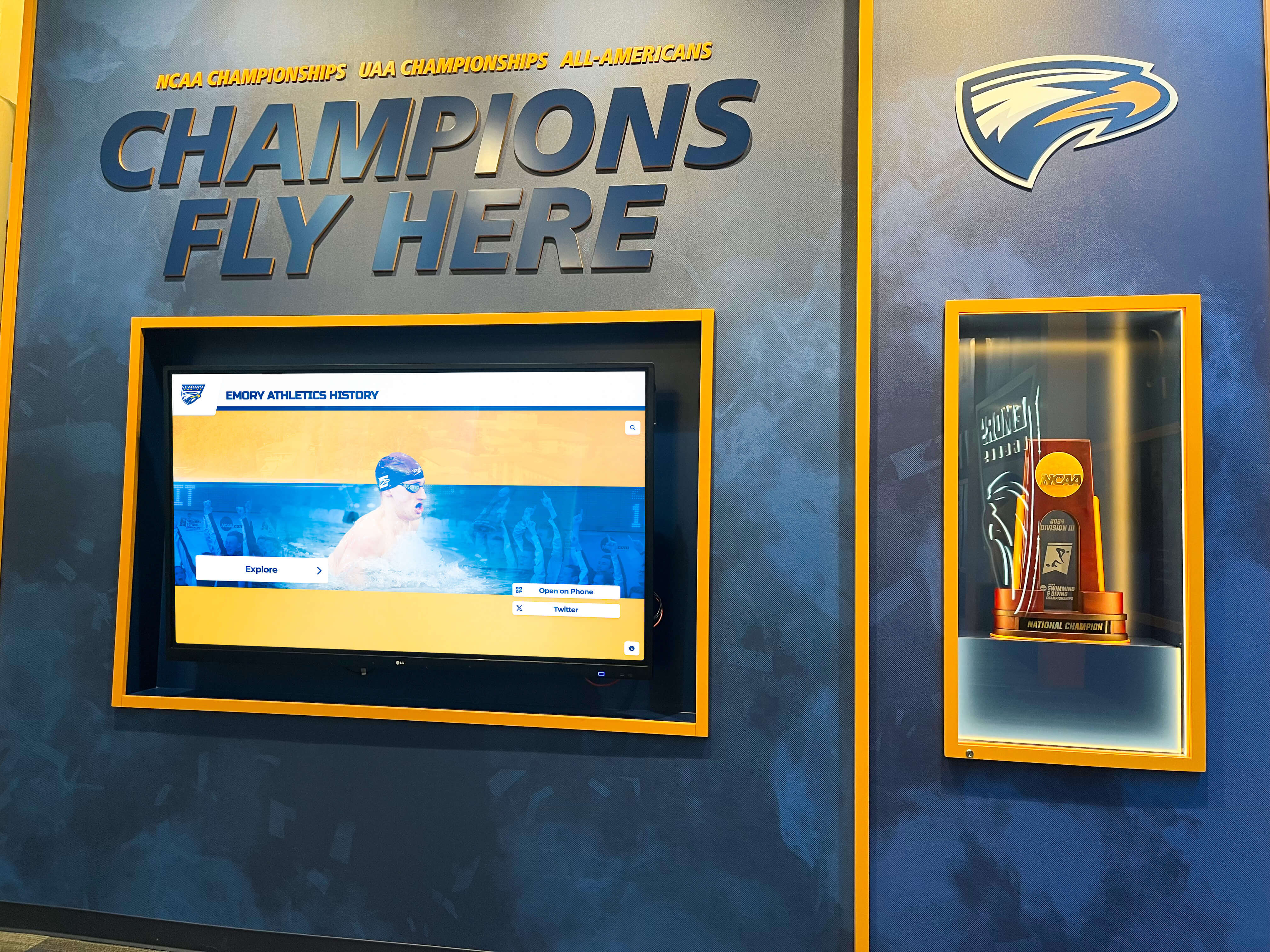
Creating Permanent Championship Recognition Displays
Beyond immediate celebrations and formal ceremonies, schools must create lasting recognition that preserves championship achievements for future generations while maintaining ongoing visibility throughout school facilities.
Traditional Championship Recognition Elements
Conventional approaches to permanent championship recognition include several established formats still commonly used in schools:
Championship banners hung in gymnasiums or competition venues provide highly visible recognition that maintains championship awareness during athletic events. Banner programs typically designate specific wall spaces for championship banners, creating organized displays that grow as programs add championships. Banners create visual impact that immediately communicates program success to visitors while reinforcing pride among current athletes who practice and compete beneath championship recognition.
Trophy case displays showcase championship trophies, team photos, and achievement documentation in protected glass cases located in high-traffic school areas. Trophy cases concentrate championship recognition in specific locations while protecting valuable championship hardware and memorabilia. However, trophy case approaches face significant limitations—physical space constraints restrict what can be displayed, cases require regular maintenance and updating, and static displays provide limited information beyond what fits on small plaques or labels.
Championship wall plaques list years when programs won state championships, creating simple chronological records of championship success. While space-efficient, plaque approaches provide minimal information about championship teams, individual athletes, or championship season contexts.
These traditional recognition elements serve important functions and remain common in many schools. However, they increasingly get supplemented or replaced by digital recognition solutions that overcome traditional format limitations while providing more comprehensive and engaging championship tributes.
Digital Championship Recognition Displays
Modern digital recognition systems transform championship commemoration by eliminating space constraints while enabling multimedia content that brings championship stories to life:
Digital platforms allow schools to create comprehensive profiles for each championship season including unlimited photographs from regular season and championship games, complete season statistics and records, individual athlete profiles with photos and biographical information, video highlights from championship competitions, coaching staff recognition, and detailed championship game or meet summaries.
This rich content creates meaningful championship recognition that preserves not just championship facts but championship stories—the narratives, personalities, and experiences that define each unique championship season. Interactive features enable visitors to search championships by year, sport, or athlete name, creating engaging exploration experiences rather than passive viewing.
Solutions like digital recognition displays from Rocket Alumni Solutions provide specialized platforms designed specifically for athletic achievement recognition. These systems offer user-friendly content management that allows athletic directors or designated staff to add championship content easily without requiring technical expertise. Schools can update displays immediately after championship victories, adding current season championships alongside historical recognition.
Digital recognition also enables remote access through web platforms, allowing alumni and community members to explore championship history from anywhere rather than only during school visits. This extended access enhances engagement while demonstrating that championship recognition serves broader communities beyond just current students and staff.
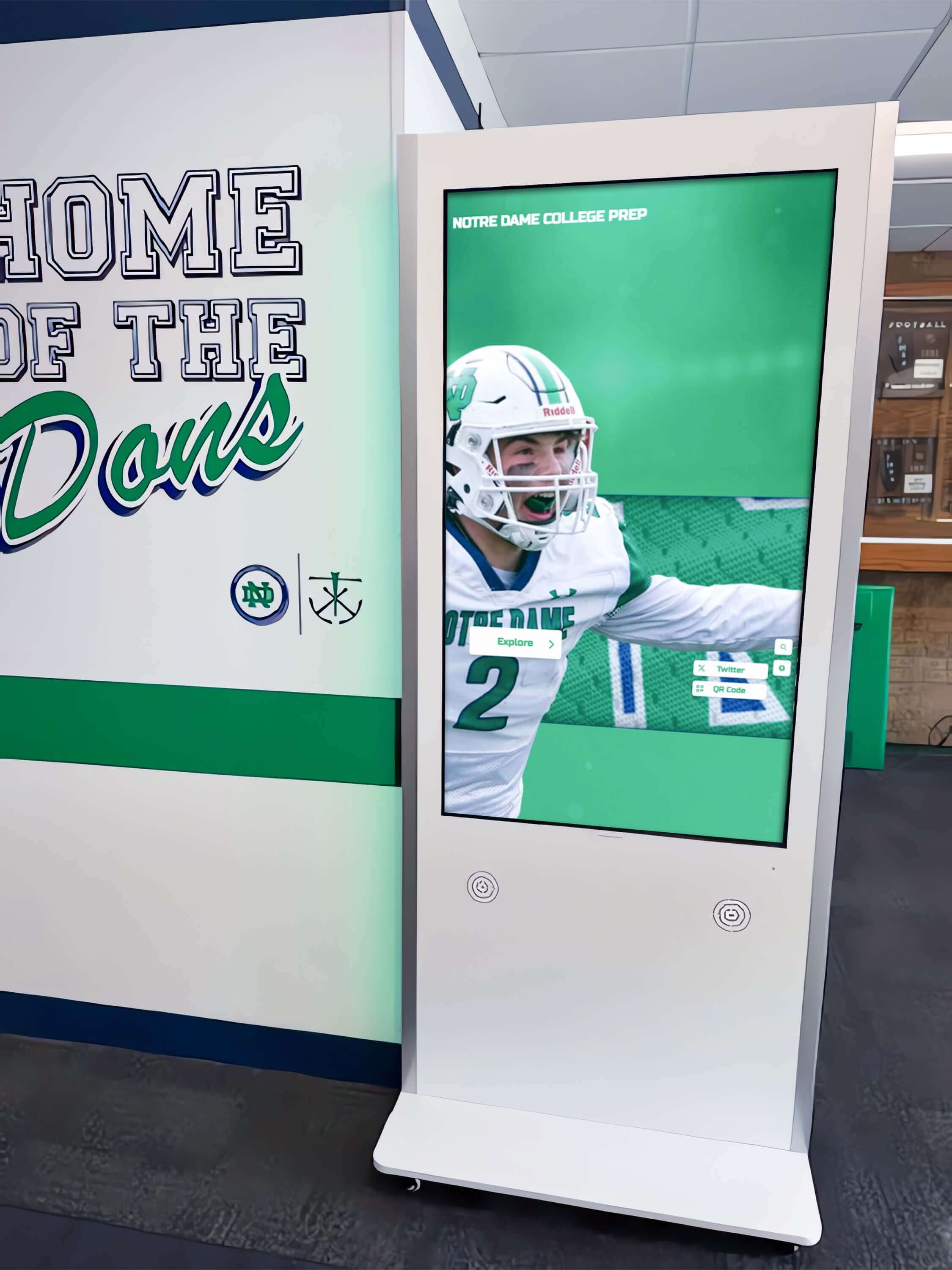
Comprehensive Championship Content
Whether using traditional or digital formats, effective championship recognition should include these essential content elements:
Championship season identification clearly specifies the sport, year, and classification level of each championship. Team composition documentation lists all team members with roster photos when possible, ensuring every athlete receives recognition regardless of playing time or role. Coaching staff recognition acknowledges head coaches, assistant coaches, and support staff who guided championship teams to success.
Season record and statistics document win-loss records, significant victories, and statistical achievements that characterized championship seasons. Championship tournament results detail playoff bracket progression, semifinal and final scores, and championship game or meet performances. Individual honors and achievements note all-state selections, player of the year awards, and individual championship accomplishments within team championships.
Season narrative and highlights provide context about championship seasons through written descriptions of key games, turning point moments, challenges overcome, and characteristics that defined championship teams. Visual documentation includes team photos, action photographs, championship trophy images, and celebration photos that provide visual richness to championship recognition.
Media coverage and community impact might reference newspaper articles, broadcast coverage, or community celebrations that demonstrate broader significance of championship achievements. This comprehensive approach ensures championship recognition tells complete stories rather than just listing basic facts.
Sport-Specific Championship Recognition
Different fall sports feature unique characteristics that should inform sport-specific recognition approaches:
Football Championship Recognition
Football’s prominence in many communities and the sport’s position as the signature fall sport in numerous regions means football state championships often receive especially elaborate recognition:
Football championship recognition frequently includes game film highlights showing key plays, touchdowns, defensive stops, and championship-deciding moments that defined championship games. Position group recognition acknowledges offensive line, defensive line, skill positions, and special teams units that contributed to championship success, ensuring recognition extends beyond just statistical leaders. Playoff journey documentation tells stories of entire playoff runs including early round victories, rivalry game triumphs, and semifinal challenges that led to championship game opportunities.
Many schools with significant football hall of fame traditions integrate championship recognition into broader football program history displays, creating comprehensive documentation of program excellence across decades. Individual season records set during championship years should receive special acknowledgment when championship teams produced record-breaking performances in addition to winning titles.
Championship game venue significance might warrant recognition when championships occurred at notable stadiums—university venues, professional stadiums, or historic high school stadiums with special meaning. The setting often contributes significantly to championship memories and deserves inclusion in recognition narratives.
Volleyball Championship Recognition
Volleyball state championships feature unique tournament formats and team dynamics that should inform recognition approaches:
Volleyball championship recognition benefits from tournament bracket documentation showing the path through pool play and elimination rounds that led to championships. Match statistics and performance highlights from championship matches preserve records of statistical achievements—kills, blocks, digs, assists, and serving aces—that determined championship outcomes.
Individual player spotlights acknowledge setters, outside hitters, middle blockers, defensive specialists, and liberos whose specialized contributions enabled championship success. Volleyball’s position specialization means comprehensive recognition should highlight diverse roles rather than focusing only on leading scorers. Tournament MVP and all-tournament team recognition acknowledges individual honors earned during championship tournaments alongside team achievements.
Championship match momentum shifts often define volleyball championships where teams overcome significant deficits or save match points to claim titles. Recognition narratives should capture these dramatic moments that make championship victories memorable and inspiring.
Soccer Championship Recognition
Soccer state championships combine individual skill, team tactics, and often dramatic moments worthy of comprehensive recognition:
Soccer championship recognition should include goal highlights and key saves through video clips preserving the specific moments—championship-winning goals, penalty kick conversions, goalkeeper heroics—that determined championships. Playoff bracket progression documents the series of victories required to reach finals, acknowledging that championship paths often include defeating rival schools or traditional powerhouses.
Scoring leaders and defensive stalwarts deserve balanced recognition that honors both offensive firepower and defensive excellence. Soccer championships often get decided by narrow margins where defensive consistency proves as crucial as scoring ability. Overtime and shootout victories when championships are decided through extra time or penalty kicks create especially dramatic championship stories worth preserving in detail.
Season journey narratives that contextualize championships within broader season arcs—early struggles overcome, mid-season improvements, peaking at tournament time—help audiences understand championship team development rather than just final outcomes.
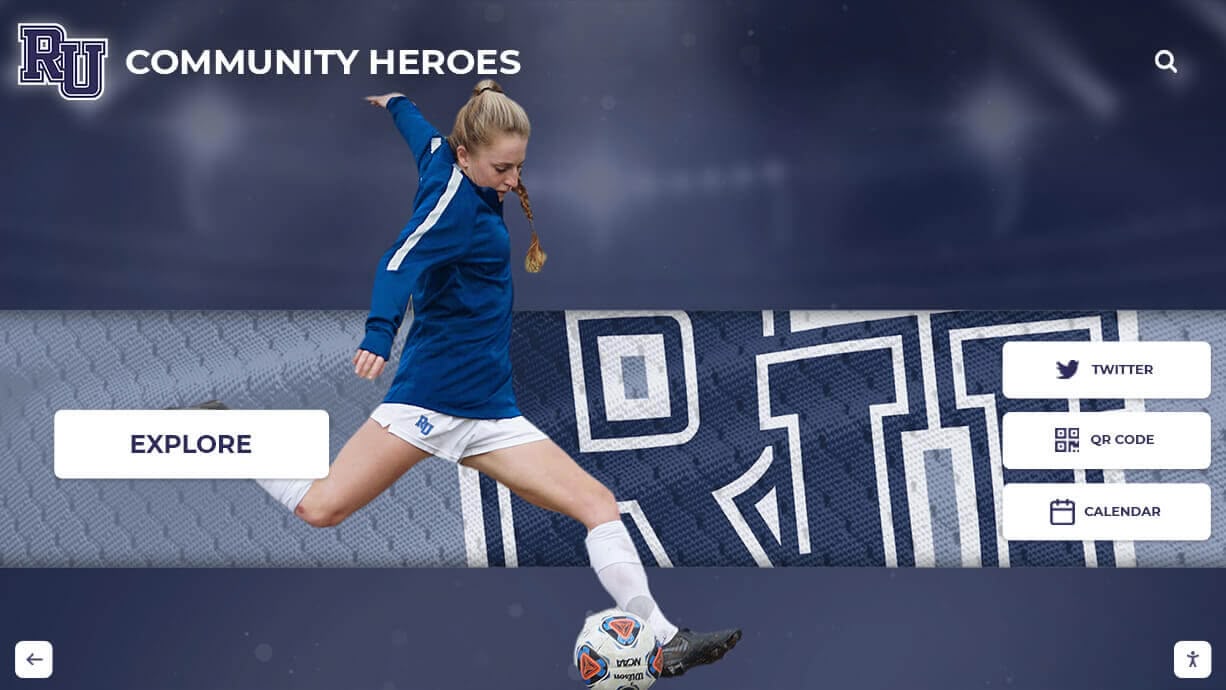
Cross Country Championship Recognition
Cross country presents unique recognition challenges since championships combine team and individual achievement through race results:
Cross country championship recognition should highlight team scoring and place distributions that explain how team championships are determined through combined runner placements. Non-runners often don’t understand cross country team scoring, so educational content explaining that lowest cumulative scores win helps audiences appreciate championship achievements.
Individual race results and finish times for all team members preserve complete records of championship race performances. Since typically seven runners compete with five scoring, recognizing all participants including non-scoring runners demonstrates comprehensive team acknowledgment. Course conditions and race narratives provide context about challenging courses, weather conditions, race strategies, and competitive challenges that defined championship races.
Season progression leading to championships often features steady improvement across the season as teams and individuals peak at championship meets. Documentation of season-long development helps audiences understand that cross country success requires sustained training and strategic preparation rather than just single-day performances. Individual state champion recognition when team members also win individual state titles deserves special acknowledgment of exceptional achievement.
Recognition that celebrates both team championships and individual excellence within team contexts provides appropriate honor for cross country’s unique competitive structure.
Engaging Alumni and Building Legacy
Championship recognition serves important functions beyond honoring current athletes—it connects past and present while building enduring program legacies:
Championship Alumni Engagement
Former championship team members often maintain strong connections to championship experiences throughout their lives, and schools can leverage these bonds to strengthen alumni relationships:
Championship reunion events bring former championship teams back to schools for milestone anniversaries—10-year, 25-year, or 50-year reunions. These events celebrate enduring bonds while providing opportunities for championship athletes to connect with current programs and inspire young athletes. Reunion events also generate valuable content for recognition displays through updated photos, reflective interviews with former champions, and documentation of championship legacy impact.
Alumni mentorship programs connect former championship athletes with current team members, creating relationships where championship experience and wisdom get transmitted to new generations. Current athletes gain invaluable perspectives from those who previously achieved championship success while former champions enjoy meaningful ongoing engagement with programs that shaped their lives.
Championship story documentation projects involve interviewing former championship team members to capture detailed first-person accounts of championship seasons, preserving memories and perspectives that might otherwise be lost. These oral history initiatives create rich content for digital recognition platforms while honoring championship veterans through requests for their stories.
Alumni engagement around championship recognition demonstrates that schools value championship achievements not just in the moment but across decades, strengthening lifelong institutional bonds.
Multi-Generational Championship Recognition
Schools fortunate enough to have produced multiple state championships in particular sports over extended time periods can create powerful multi-generational recognition that connects championship eras:
Championship timeline displays present chronological championship histories that allow viewers to explore how programs evolved across decades. Visual timelines might show all championship years, team photos from each era, coaching changes across championship periods, and how uniforms and equipment evolved over time.
Championship tradition narratives identify common elements across championship teams—program philosophies, training approaches, school traditions—that persist across generations and contribute to sustained championship success. These narratives help current athletes understand they are part of larger championship traditions rather than isolated teams.
Comparative statistics and achievements let audiences compare championship teams across eras—which teams posted best records, achieved most dominant tournament performances, or featured most all-state performers. While all championships deserve equal honor, comparative elements create engaging content that stimulates discussion and appreciation of different championship team characteristics.
Multi-generational championship recognition builds comprehensive program histories that enhance school pride while providing inspiration for current athletes who aspire to add new chapters to championship legacies.
Integrating Championships Into School Culture
Maximum championship recognition impact occurs when championships become woven into broader school culture rather than existing as isolated displays:
Championship Traditions and Rituals
Schools can establish consistent traditions around championship celebration that become anticipated elements of school culture:
Championship assembly traditions scheduled specifically to honor championship teams create recurring cultural moments. When school communities know championship assemblies will occur each time teams win state titles, anticipation builds while championship recognition becomes expected institutional practice rather than ad-hoc response.
Championship banner unveiling ceremonies held during first home events following championships—where new championship banners get revealed and raised before assembled crowds—create ritualistic celebration moments. The ceremonial nature adds significance while involving broader athletic communities in championship recognition.
Championship legacy projects where championship teams contribute to schools beyond just their athletic achievements—perhaps establishing scholarship funds, mentoring programs, or community service initiatives—connect championships to lasting positive impact. These legacy projects demonstrate that championship success brings responsibilities and opportunities to give back to communities that supported championship pursuits.
Established traditions transform championship recognition from sporadic reactions into consistent cultural practices that define how schools honor athletic excellence.
Educational Integration
Championship achievements can be integrated into academic contexts to enhance learning while building school-wide awareness:
Math and statistics lessons might analyze championship season statistics, playoff probability calculations, or historical championship frequency to make mathematical concepts relevant through familiar athletic contexts. Writing assignments could task students with researching and writing about school championship history, creating student-generated content while building historical awareness.
Physical education connections allow PE teachers to discuss championship training approaches, athletic development principles, or sport-specific skills using school’s own championship teams as examples. This integration makes PE content more relevant while honoring championship achievements across school curriculum. School history and tradition education for new students should include championship achievement awareness, ensuring all students understand significant athletic accomplishments that are part of their schools’ identities.
Academic integration demonstrates that athletic championships represent whole-school achievements worthy of recognition across all institutional functions rather than just within athletic departments.
Measuring Championship Recognition Impact
Schools investing in comprehensive championship recognition should assess program effectiveness through various measures:
Current Athlete Motivation and Awareness
Survey or interview current athletes about whether they know school championship history, feel inspired by past championship teams, understand what championship achievements required, and aspire to pursue championship success themselves. Effective recognition should increase motivation and achievement orientation among current athletes who see tangible evidence that championship success is possible and appropriately honored.
Alumni Satisfaction and Connection
Gather feedback from former championship team members about whether they feel appropriately recognized, maintain strong connections to schools and athletic programs, participate in alumni events or engagement opportunities, and support programs through volunteering or philanthropy. Quality championship recognition should strengthen alumni relationships and generate lasting goodwill.
Community Awareness and Pride
Monitor community awareness of school championship achievements, community pride in athletic program success, attendance at athletic events, and booster club participation and support. Championship recognition should enhance community pride while building broader support for athletic programs.
Recruitment and Program Building
Track whether championship recognition influences athlete family school selection decisions, generates interest from talented athletes seeking quality programs, attracts coaches interested in programs with championship tradition, and contributes to sustained competitive success. Effective championship recognition can help programs maintain excellence by attracting talent and building positive reputations.
Assessment provides data demonstrating championship recognition program value while identifying opportunities to enhance effectiveness and impact.
Conclusion: Preserving Championship Excellence
Fall sports state championships represent pinnacle achievements resulting from exceptional talent, dedicated preparation, strong coaching, and supportive school communities coming together to produce athletic excellence. These championship moments deserve recognition that honors their significance while preserving championship stories for future generations who will draw inspiration from documented excellence.
The evolution from space-limited trophy cases and simple championship banners to comprehensive digital recognition systems has fundamentally transformed what’s possible in championship recognition. Schools no longer must choose which championships receive limited display space or accept minimal information presentation. Modern solutions enable unlimited recognition capacity, rich multimedia content, engaging interactive experiences, and accessible platforms that serve broad communities beyond just school visitors.
Whether celebrating football championships won under Friday night lights, volleyball championships claimed through tournament excellence, soccer championships secured through playoff victories, or cross country championships earned through grueling races, each fall sports championship carries unique stories deserving comprehensive recognition. Effective recognition preserves not just championship facts but championship experiences—the struggles, triumphs, personalities, and moments that define each championship journey.
For schools committed to appropriately honoring fall sports state championship achievements, modern digital recognition displays from Rocket Alumni Solutions provide comprehensive platforms that overcome traditional limitation while creating engaging, lasting tributes to athletic excellence. These systems enable schools to celebrate championship traditions while building interactive experiences that inspire current athletes to pursue their own championship dreams.
Whether your school celebrates its first-ever state championship or adds to a rich championship legacy spanning decades, the right recognition approach ensures these exceptional achievements receive the honor they deserve while remaining visible and inspiring for generations to come.
